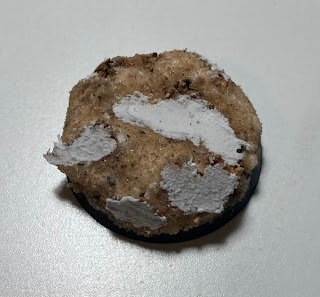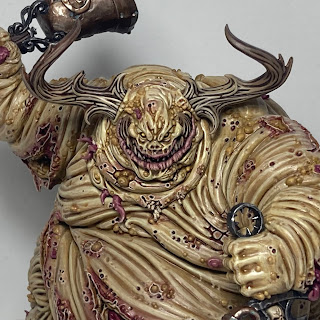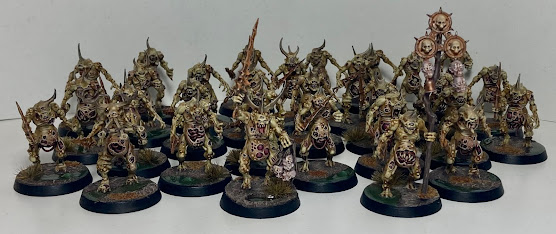Begun in Spring 2019, initially as just a small warband for a Path to Glory campaign at my once local GW, I’ve slowly (even by my standards) built up this Maggotkin army to its present size of around 1750 points in AoS 3rd edition.
The painting style and colour scheme on the mortal Rotbringers side was heavily influenced by Johan Egerkrans' fantastic Warband of Lord Mawgut Gloop; the darker aesthetic appealed a lot more to me than the brighter colours used in many of the studio-style Maggotkin armies. For the daemonic side, the inspiration of Tyler Mengel's various excellent guides is no doubt visible, not least on my GUO, on which more to follow.
Looking back, the earliest photo of any work on the collection is from May 2019, after deciding mid-painting session that the rather unassuming figure of my first Blightkings unit champion needed something a little extra to make him stand out. Some greenstuff later and he was decked out with a rather fetching tricorne hat.
As I slowly built up the army, I was keen to incorporate similar adornments and characterful details into each of my Blightkings units. As a big fan of the Rotbringers side of the army (and small, portable forces; sorry Pusgoyles), I knew that Blightkings would make up the bulk of my battleline.
Although there is some good opportunity for variation in the basic models, with plenty of alternate weapons and torsos to choose from, the options for musicians and standard bearers are considerably fewer. With their naturally taller profiles than the regular members of each unit, any kitbashing of the banners and bells between different blocks would thus help considerably to break up the silhouette of the army, while also drawing in the viewer’s attention for a closer inspection of the more subtle variations between units. So far, I’ve managed to avoid any repetition in these models across all twenty Blightkings from the army.
Particular favourites are the bell-helmeted ‘Brother Tinnitus’ from the block of ten to accompany (a soon-to-be painted) Gutrot Spume…
And a rather grim corpse-banner, borrowed from the Pusgoyle sprue, placed in the second block of five.
Overall I'm quite a bit happier with these later fifteen Blightkings, painted up during the first stages of the pandemic last year, than with my original unit of five from 2019—I might end up retouching those early models and redistributing them among other units or else simply retiring them and painting up some more.
Another early addition was the Harbinger of Decay; a rather aged sculpt but one of my favourites from my first foray into the hobby during 6th edition fantasy—a period that cemented my love of Nurgle, thanks largely to Asger Granerud’s fantastic army that he built up during the revamped ‘A Tale of Four Gamers’ from White Dwarf 300 onwards.
The once ubiquitous Lord of Blights doesn’t look set to feature in too many 3rd edition lists, now that his battalion has been relegated from matched play—a shame given the scenic base that I made for him with bits from the Laketown House kit, but ah well, it’s a nice sculpt at least.
The first BIG-hammer addition to the army was a support GUO in blade and bell loadout. I’m not usually a fan of huge models—they’re so awkward to hold while painting—but this one is an exception. Originally painted for the ill-fated Everchosen contest of 2020, he easily consumed the most hours of hobby time in the army and is definitely my favourite model in the collection.
Rounding off the champions for now is Fecula Flyblown from the Wurmspat trio, proxying as a Rotbringers Sorceress. There’s little that I can add to what’s already been said about Warhammer Underworlds sculpts; I love mixing them into units to add visual interest and they’re worryingly easy to pick up for armies one doesn’t (already) collect.
Last, but certainly not least, are the most recent addition—a tarpit of thirty Plaguebearers. I’m not sure whether I’ll field these as a single block in games of third edition; two blocks of twenty prove better, and they were quite fun to paint after all.
Currently on the hobby desk is the aforementioned Gutrot and a Feculent Gnarlmaw that I’ve been putting off painting for about two years at this point. I really should run two in the list but it’s a frustratingly detailed sculpt for what is, at the end of the day, just a tree. Still unpainted are two Pusgoyles which, given the loss of a battalion and some not too consequential points changes to Nurgle, would pull the army back up to the golden 2,000 number.
With a new Battletome surely imminent (it’s only a matter of time, being currently the oldest rulebook in AoS), I’m loathe to pick up anything new for the army until I’ve had a chance to see what new shinies might be on their way. That being said, with the combination of third edition’s Monstrous Rampages and the wonders of magnet storage slowly convincing me that BIG models aren’t the work of the devil, those Maggoth Lords are looking awfully tempting…















